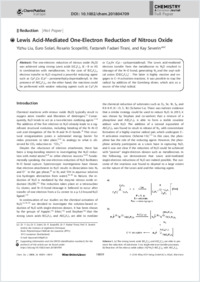Lewis Acid-Mediated One-Electron Reduction of Nitrous Oxide.
- Liu Y Institut des Sciences et Ingénierie Chimiques, École Polytechnique Fédérale de Lausanne (EPFL), 1015, Lausanne, Switzerland.
- Solari E Institut des Sciences et Ingénierie Chimiques, École Polytechnique Fédérale de Lausanne (EPFL), 1015, Lausanne, Switzerland.
- Scopelliti R Institut des Sciences et Ingénierie Chimiques, École Polytechnique Fédérale de Lausanne (EPFL), 1015, Lausanne, Switzerland.
- Fadaei Tirani F Institut des Sciences et Ingénierie Chimiques, École Polytechnique Fédérale de Lausanne (EPFL), 1015, Lausanne, Switzerland.
- Severin K Institut des Sciences et Ingénierie Chimiques, École Polytechnique Fédérale de Lausanne (EPFL), 1015, Lausanne, Switzerland.
- 2018-11-15
Published in:
- Chemistry (Weinheim an der Bergstrasse, Germany). - 2018
English
The one-electron reduction of nitrous oxide (N2 O) was achieved using strong Lewis acids E(C6 F5 )3 (E=B or Al) in combination with metallocenes. In the case of B(C6 F5 )3 , electron transfer to N2 O required a powerful reducing agent such as Cp*2 Co (Cp*=pentamethylcyclopentadienyl). In the presence of Al(C6 F5 )3 , on the other hand, the reactions could be performed with weaker reducing agents such as Cp*2 Fe or Cp2 Fe (Cp=cyclopentadienyl). The Lewis acid-mediated electron transfer from the metallocene to N2 O resulted in cleavage of the N-O bond, generating N2 and the oxyl radical anion [OE(C6 F5 )3 ]⋅- . The latter is highly reactive and engages in C-H activation reactions. It was possible to trap the radical by addition of the Gomberg dimer, which acts as a source of the trityl radical.
- Language
-
- English
- Open access status
- green
- Identifiers
-
- DOI 10.1002/chem.201804709
- PMID 30426605
- Persistent URL
- https://folia.unifr.ch/global/documents/37616
Statistics
Document views: 23
File downloads:
- fulltext.pdf: 0
